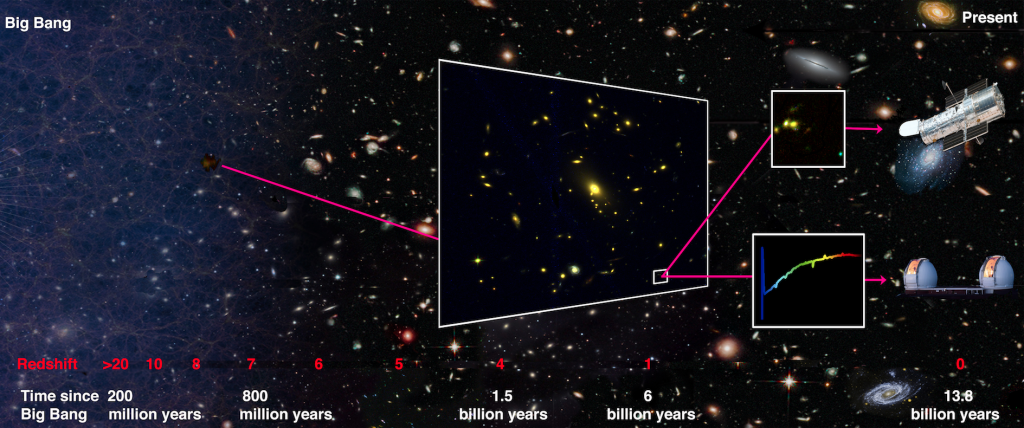Maunakea Telescope Aids in Discovery of Primordial Galaxy

UC Davis Associate Physics Professor Dr. Marusa Bradac and UC Davis Physics Graduate Student Austin Hoag at the W. M. Keck Observatory. CREDIT: M. BRADAC/A. HOAG
Seven years of meticulous observing has resulted in a cosmic discovery that comes from an era dating back 13.1 billion years, giving scientists a detailed glimpse of what may have happened just after the Big Bang.
Using the world-class W. M. Keck Observatory on Maunakea, an international team of astronomers from the United States, Australia and Europe has confirmed the existence of one of the most distant galaxies in the universe.
To characterize the faint galaxy, the discovery team led by Austin Hoag, a University of California, Davis, physics graduate student, used MOSFIRE, the most in-demand instrument on the 10-meter Keck I telescope.

Graphic illustration of how MACS1423-z7p64 was detected via gravitational lensing with NASA’s Hubble Space Telescope and confirmed by W. M. Keck Observatory’s MOSFIRE. CREDIT: NASA/W. M. KECK OBSERVATORY/A. HOAG/M. BRADAC
What makes this galaxy extraordinary is that it is ordinary.
It is thought to be a common galaxy at that distance and age of the universe. However, such galaxies would normally be too faint to detect. The astronomers used a method called gravitational lensing to magnify the galaxy so they could study it.
“Most objects that we’ve seen at that distance are extremely bright and probably rare compared to other galaxies,” said Hoag. “We think this galaxy is much more representative of other galaxies of its time.”
The results were published in Nature Astronomy, with Hoag as the lead author on the paper.
“I’m like a proud academic mother,” said Marusa Bradac, associate physics professor at UC Davis. “It is a wonderful opportunity for graduate students to use the world’s best facilities to discover first galaxies and get their research published in Nature Astronomy.”
Named MACS1423-z7p64, the galaxy is at a redshift of 7.6, meaning its light came from when the universe was approximately 700 million years old.
“This is an awesome discovery in that it is the faintest galaxy at that redshift ever detected,” said Keck Observatory Instrument Program Manager Marc Kassis who, along with fellow support astronomers Luca Rizzi and Carlos Alvarez, helped support Hoag and his team. “It is very challenging to find an object at the very edges of the universe. In order to detect this galaxy, its light had to be lensed twice—once by a massive galaxy cluster and a second time by the Keck Observatory telescope,”
To find such faint, distant objects, the discovery team took advantage of a method called gravitational lensing. As light from the distant object passes by a massive object, such as a galaxy cluster in the foreground, it gets bent by gravity, just as light gets bent passing through a lens. When the foreground object is massive enough, it will magnify the object behind it.
MACS1423-z7p64 just happened to fall into the “sweet spot” behind a giant galaxy cluster that magnified its brightness tenfold and made it first visible to the team using the Hubble Space Telescope. They were then able to confirm its distance by analyzing its spectrum using Keck Observatory’s MOSFIRE.
Even though MACS1423-z7p64 is strongly magnified, the discovery has been extremely challenging and it required combining the initial data taken by UC Davis researchers in 2015 with those from a second night of Keck observations from Australian colleagues at the University of Melbourne in 2016.
“This detection of Lyman-α emission from the galaxy thus highlights the strength of collaborative research projects,” said Michele Trenti from the University of Melbourne, principal investigator of the Australian observations.
“This is yet another discovery that puts UC Davis, UCLA and University of Melbourne on the map as among the top astronomy centers in their nations, and the reason for that is due to our access to the Keck telescopes,” said Bradac. “For this kind of research, every meter of telescopic aperture counts, and without the low humidity on Maunakea, we would not have been able to discover this.”
















